Development of a Drought Assessment Index Coupling Physically Based Constraints and Data-Driven Approaches
Abstract
Highlights
- Developed a Multivariate Drought Index combining mechanism constraints with data-driven approaches.
- MDI detects drought 16–20 days earlier and identifies <10 ha patches at 250 m.
- Provides a reliable tool for early drought warning and precision agricultural water management.
- Offers a transferable framework for scalable, interpretable drought monitoring under climate change.
Abstract
1. Introduction
- (1)
- To propose an MDI that integrates multiple drought-related factors while maintaining high spatiotemporal resolution, thereby enabling more accurate characterization of drought evolution in maize-growing regions;
- (2)
- To systematically evaluate the performance and advantages of the MDI in drought monitoring through comparative analysis with commonly used indices, highlighting its improvements in capturing spatiotemporal dynamics;
- (3)
- To identify and analyze the spatiotemporal patterns and evolutionary processes of drought in maize cultivation areas of Heilongjiang Province based on the MDI, thereby providing scientific reference for regional agricultural drought mitigation and water resource management.
2. Research Data and Methodology
2.1. Overview of the Study Area
| Indicator | Data Source | Observation Dimension | Physical Significance | Formula |
|---|---|---|---|---|
| NDWI | MOD09 | Canopy moisture | Sensitivity to vegetation water stress [33] | |
| TVDI | MOD11 | Hydrothermal condition | Degree of relative soil drought [34] | |
| VCI | MOD13 | Vegetation vigor | Vegetation growth anomaly [35] | |
| TCI | MOD11 | Thermal condition | High-temperature/heat stress [35] | |
| DEM | RESDC | Topography | Spatial hydrothermal constraint factor |
2.2. Indicator Groups and Observation Dimension Configuration
2.3. Methodology for Constructing the Comprehensive Drought IndexOther
2.3.1. Input Construction
2.3.2. Index Calculation and Normalization
2.3.3. Weight Determination
2.3.4. Integrated Output
2.4. Validation Metrics
3. Results
3.1. Performance Evaluation of Single Remote Sensing Drought Indices
3.2. Weight Allocation and Validation of Feature Importance
3.3. Comparative Performance and Responsiveness of MDI
3.4. Spatial Patterns of MDI
4. Discussion
4.1. Driving Factors and Interpretation of Index Contributions
4.2. Advantages of the MDI
4.3. Limitations and Future Prospects
5. Conclusions
Author Contributions
Funding
Data Availability Statement
Acknowledgments
Conflicts of Interest
References
- Battisti, D.S.; Naylor, R.L. Historical warnings of future food insecurity with unprecedented seasonal heat. Science 2009, 323, 240–244. [Google Scholar] [CrossRef]
- Mao, H.; Sun, Z.; Chai, A.; Fang, L.; Shi, C. Extreme weather, agricultural insurance and farmer’s climate adaptation technologies adoption in China. Ecol. Econ. 2025, 228, 108456. [Google Scholar] [CrossRef]
- Chen, J.; Chan, F.K.S.; Wang, J.; Feng, M.; Wang, Z.; Altansukh, O.; Shao, Y.; Li, P.; Wang, J. Potential challenges and food security responses to climate change in China and Mongolia in the post-COP28 era. J. Resour. Ecol. 2025, 16, 22–35. [Google Scholar] [CrossRef]
- Shi, Y.; Wang, F.; Wang, Y.; Jia, L. The Maize Supply Chain Coordination Mechanism under Yield Uncertainty Caused by Drought: A Study in the Heilongjiang Province of China. Sustainability 2023, 15, 11319. [Google Scholar] [CrossRef]
- Guo, E.; Liu, X.; Zhang, J.; Wang, Y.; Wang, C.; Wang, R.; Li, D. Assessing spatiotemporal variation of drought and its impact on maize yield in Northeast China. J. Hydrol. 2017, 553, 231–247. [Google Scholar] [CrossRef]
- Li, Q.; Gao, Y.; Hamani, A.K.M.; Wang, G.; Liu, J.; Fu, Y.; Wang, X. Effects of warming and drought stress on the growth characteristics, photosynthetic-transpiration rates, and yield of winter wheat. Int. J. Agric. Biol. Eng. 2024, 17, 121–129. [Google Scholar] [CrossRef]
- Wang, Y.; Zhang, S.; Xu, Y.; Que, L.; Li, X.; Huang, Y.; Chen, X.; Wang, L. Meteorological drought and atmospheric circulation anomalies characteristics in Heilongjiang Province from May to September in recent 50 years. Arid Meteorol. 2023, 41, 540–549. [Google Scholar]
- Park, S.-Y.; Sur, C.; Kim, J.-S.; Lee, J.-H. Evaluation of multi-sensor satellite data for monitoring different drought impacts. Stoch. Environ. Res. Risk Assess. 2018, 32, 2551–2563. [Google Scholar] [CrossRef]
- Alahacoon, N.; Edirisinghe, M. A comprehensive assessment of remote sensing and traditional based drought monitoring indices at global and regional scale. Geomat. Nat. Hazards Risk 2022, 13, 762–799. [Google Scholar] [CrossRef]
- Yu, H.; Zhang, Q.; Xu, C.Y.; Du, J.; Sun, P.; Hu, P. Modified palmer drought severity index: Model improvement and application. Environ. Int. 2019, 130, 104951. [Google Scholar] [CrossRef]
- Šebenik, U.; Brilly, M.; Šraj, M. Drought analysis using the standardized precipitation index (SPI). Acta Geogr. Slov. 2017, 57, 31–49. [Google Scholar] [CrossRef]
- Guttman, N.B. Comparing the palmer drought index and the standardized precipitation index 1. J. Am. Water Resour. Assoc. 1998, 34, 113–121. [Google Scholar] [CrossRef]
- Feng, P.; Wang, B.; Liu, D.L.; Yu, Q. Machine learning-based integration of remotely-sensed drought factors can improve the estimation of agricultural drought in South-Eastern Australia. Agric. Syst. 2019, 173, 303–316. [Google Scholar] [CrossRef]
- Xu, Z.; Sun, H.; Zhang, T.; Xu, H.; Wu, D.; Gao, J.H. The high spatial resolution Drought Response Index (HiDRI): An integrated framework for monitoring vegetation drought with remote sensing, deep learning, and spatioteporal fusion. Remote Sens. Environ. 2024, 312, 114324. [Google Scholar] [CrossRef]
- Watson, K.; Hummer-Miller, S. A simple algorithm to estimate the effective regional atmospheric parameters for thermal-inertia mapping. Remote Sens. Environ. 1981, 11, 455–462. [Google Scholar] [CrossRef]
- Price, J.C. On the analysis of thermal infrared imagery: The limited utility of apparent thermal inertia. Remote Sens. Environ. 1985, 18, 59–73. [Google Scholar] [CrossRef]
- Tucker, C.J. Red and photographic infrared linear combinations for monitoring vegetation. Remote Sens. Environ. 1979, 8, 127–150. [Google Scholar] [CrossRef]
- Kogan, F.; Sullivan, J. Development of global drought-watch system using NOAA/AVHRR data. Adv. Space Res. 1993, 13, 219–222. [Google Scholar] [CrossRef]
- Kogan, F.N. Application of vegetation index and brightness temperature for drought detection. Adv. Space Res. 1995, 15, 91–100. [Google Scholar] [CrossRef]
- Wang, W.; Zang, Y.; Li, G. Estimation and spatial character analysis of vegetation net primary productivity in Heilongjiang Province. In MIPPR 2011: Remote Sensing Image Processing, Geographic Information Systems, and Other Applications, Proceedings of the Seventh International Symposium on Multispectral Image Processing and Pattern Recognition (MIPPR2011), Guilin, China, 4–6 November 2011; SPIE: Bellingham, DC, USA, 2011; Volume 8006, pp. 192–199. [Google Scholar]
- Zhou, X.; Wang, P.; Tansey, K.; Zhang, S.; Li, H.; Wang, L. Developing a fused vegetation temperature condition index for drought monitoring at field scales using Sentinel-2 and MODIS imagery. Comput. Electron. Agric. 2020, 168, 105144. [Google Scholar] [CrossRef]
- Wu, L.; Zhang, Y.; Wang, L.; Xie, W.; Song, L.; Zhang, H.; Bi, H. Analysis of 22-year Drought Characteristics in Heilongjiang Province Based on Temperature Vegetation Drought Index. Comput. Intell. Neurosci. 2022, 2022, 1003243. [Google Scholar] [CrossRef] [PubMed]
- Xing, Z.; Yang, Z.; Fu, Q.; Li, H.; Gong, X.; Wu, J. Characteristics and risk assessment of agricultural meteorological disasters based on 30 years’ disaster data from Heilongjiang Province of China. Int. J. Agric. Biol. Eng. 2017, 10, 144–154. [Google Scholar] [CrossRef]
- Du, L.; Tian, Q.; Yu, T.; Meng, Q.; Jancso, T.; Udvardy, P.; Huang, Y. A comprehensive drought monitoring method integrating MODIS and TRMM data. Int. J. Appl. Earth Obs. Geoinf. 2013, 23, 245–253. [Google Scholar] [CrossRef]
- Rajsekhar, D.; Singh, V.P.; Mishra, A.K. Multivariate drought index: An information theory based approach for integrated drought assessment. J. Hydrol. 2015, 526, 164–182. [Google Scholar] [CrossRef]
- Adnan, R.M.; Dai, H.-L.; Kuriqi, A.; Kisi, O.; Zounemat-Kermani, M. Improving drought modeling based on new heuristic machine learning methods. Ain Shams Eng. J. 2023, 14, 102168. [Google Scholar] [CrossRef]
- Cai, S.; Zuo, D.; Wang, H.; Xu, Z.; Wang, G.; Yang, H. Assessment of agricultural drought based on multi-source remote sensing data in a major grain producing area of Northwest China. Agric. Water Manage. 2023, 278, 108142. [Google Scholar] [CrossRef]
- Schwartz, C.; Ellenburg, C.W.; Mishra, V.; Mayer, T.; Griffin, R.; Qamer, F.; Matin, M.; Tadesse, T. A statistical evaluation of Earth-observation-based composite drought indices for a localized assessment of agricultural drought in Pakistan. Int. J. Appl. Earth Obs. Geoinf. 2022, 106, 102646. [Google Scholar] [CrossRef]
- Fu, Q.; Zhou, Z.; Li, T.; Liu, D.; Hou, R.; Cui, S.; Yan, P. Spatiotemporal characteristics of droughts and floods in northeastern China and their impacts on agriculture. Stoch. Environ. Res. Risk Assess. 2018, 32, 2913–2931. [Google Scholar] [CrossRef]
- Zhao, Q.; Zou, C.H.; Wang, K.F.; Gao, Q.; Yao, T. Spatial and temporal distribution characteristics of drought and its influencing factors in Heilongjiang Province, China from 1956 to 2015. Appl. Ecol. Environ. Res. 2019, 17, 2631–2650. [Google Scholar] [CrossRef]
- Xu, X.Z.; Xu, Y.; Chen, S.C.; Xu, S.G.; Zhang, H.W. Soil loss and conservation in the black soil region of Northeast China: A retrospective study. Environ. Sci. Policy 2010, 13, 793–800. [Google Scholar] [CrossRef]
- Heilongjiang Provincial Bureau of Statistics. Heilongjiang Statistical Yearbook; Heilongjiang People’s Publishing House: Harbin, China, 2019.
- Vicente-Serrano, S.M.; Beguería, S.; López-Moreno, J.I. A multiscalar drought index sensitive to global warming: The standardized precipitation evapotranspiration index. J. Clim. 2010, 23, 1696–1718. [Google Scholar] [CrossRef]
- Cai, X.; Zhang, X.; Pan, M.; Zhu, Q. SMCI1.0: A high-quality soil moisture dataset for China (2000–2020) derived from in situ observations. Earth Syst. Sci. Data 2021, 13, 3217–3236. [Google Scholar]
- Gao, B.-C. NDWI—A normalized difference water index for remote sensing of vegetation liquid water from space. Remote Sens. Environ. 1996, 58, 257–266. [Google Scholar] [CrossRef]
- Sandholt, I.; Rasmussen, K.; Andersen, J. A simple interpretation of the surface temperature/vegetation index space for assessment of surface moisture status. Remote Sens. Environ. 2002, 79, 213–224. [Google Scholar] [CrossRef]
- Diakoulaki, D.; Mavrotas, G.; Papayannakis, L. Determining objective weights in multiple criteria problems: The critic method. Comput. Oper. Res. 1995, 22, 763–770. [Google Scholar] [CrossRef]
- Willmott, C.J. Some comments on the evaluation of model performance. Bull. Am. Meteorol. Soc. 1982, 63, 1309–1313. [Google Scholar] [CrossRef]
- Congalton, R.G. A review of assessing the accuracy of classifications of remotely sensed data. Remote Sens. Environ. 1991, 37, 35–46. [Google Scholar] [CrossRef]
- Jackson, R.D.; Idso, S.B.; Reginato, R.J.; Pinter, P.J., Jr. Canopy temperature as a crop water stress indicator. Water Resour. Res. 1981, 17, 1133–1138. [Google Scholar] [CrossRef]
- Lundberg, S.M.; Lee, S.-I. A unified approach to interpreting model predictions. Adv. Neural Inf. Process. Syst. 2017, 30, 4768–4777. [Google Scholar]
- Montgomery, D.C.; Runger, G. Applied Statistics and Probability for Engineers; John Wiley & Sons: Hoboken, NJ, USA, 2010. [Google Scholar]
- GB/T 20481–2017; Grades of Meteorological Drought. China Meteorological Administration: Beijing, China, 2017.
- Xiao, X.; Ming, W.; Luo, X.; Yang, L.; Li, M.; Yang, P.; Ji, X.; Li, Y. Leveraging multisource data for accurate agricultural drought monitoring: A hybrid deep learning model. Agric. Water Manag. 2024, 293, 108692. [Google Scholar] [CrossRef]
- Hao, Z.; Singh, V.P. Drought characterization from a multivariate perspective: A review. J. Hydrol. 2015, 527, 668–678. [Google Scholar] [CrossRef]
- Qin, H.; Schaefer, D.A.; Shen, T.; Wang, J.; Liu, Z.; Chen, H.; Hu, P.; Zhu, Y.; Cheng, J.; Wu, J.; et al. Drought Driving Factors as Revealed by Geographic Detector Model and Random Forest in Yunnan, China. Forests 2025, 16, 505. [Google Scholar] [CrossRef]
- Li, J.; Li, Y.; Yin, L.; Zhao, Q. A novel composite drought index combining precipitation, temperature and evapotranspiration used for drought monitoring in the Huang-Huai-Hai Plain. Agric. Water Manag. 2024, 291, 108626. [Google Scholar] [CrossRef]
- Xu, Z.; Sun, H.; Zhang, T.; Xu, H.; Wu, D.; Gao, J. Evaluating established deep learning methods in constructing integrated remote sensing drought index: A case study in China. Agric. Water Manag. 2023, 286, 108405. [Google Scholar] [CrossRef]
- Li, X.; Lyu, Y.; Zhu, B.; Liu, L.; Song, K. Maize yield estimation in Northeast China’s black soil region using a deep learning model with attention mechanism and remote sensing. Sci. Rep. 2025, 15, 12927. [Google Scholar] [CrossRef]
- Kennedy, B.; Pouliot, D.; Manseau, M.; Fraser, R.; Duffe, J.; Pasher, J.; Chen, W.; Olthof, I. Assessment of Landsat-based terricolous macrolichen cover retrieval and change analysis over caribou ranges in northern Canada and Alaska. Remote Sens. Environ. 2020, 240, 111694. [Google Scholar] [CrossRef]
- Zhu, X.; Xu, K.; Liu, Y.; Guo, R.; Chen, L. Assessing the vulnerability and risk of maize to drought in China based on the AquaCrop model. Agric. Syst. 2021, 189, 103040. [Google Scholar] [CrossRef]
- He, K.; Zhang, X.; Ren, S.; Sun, J. Deep residual learning for image recognition. In Proceedings of the IEEE Conference on Computer Vision and Pattern Recognition, Las Vegas, NV, USA, 27–30 June 2016; pp. 770–778. [Google Scholar]

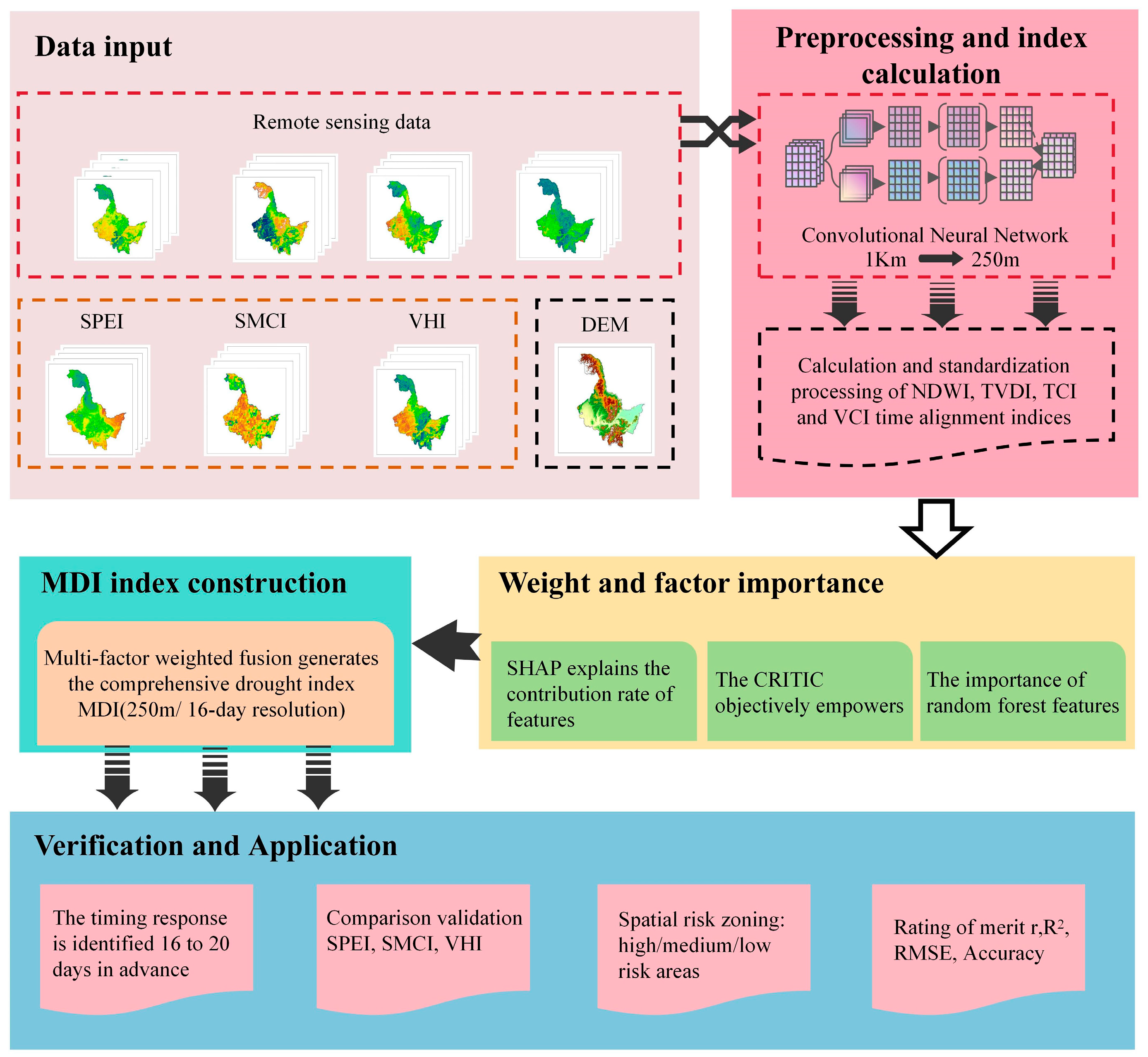
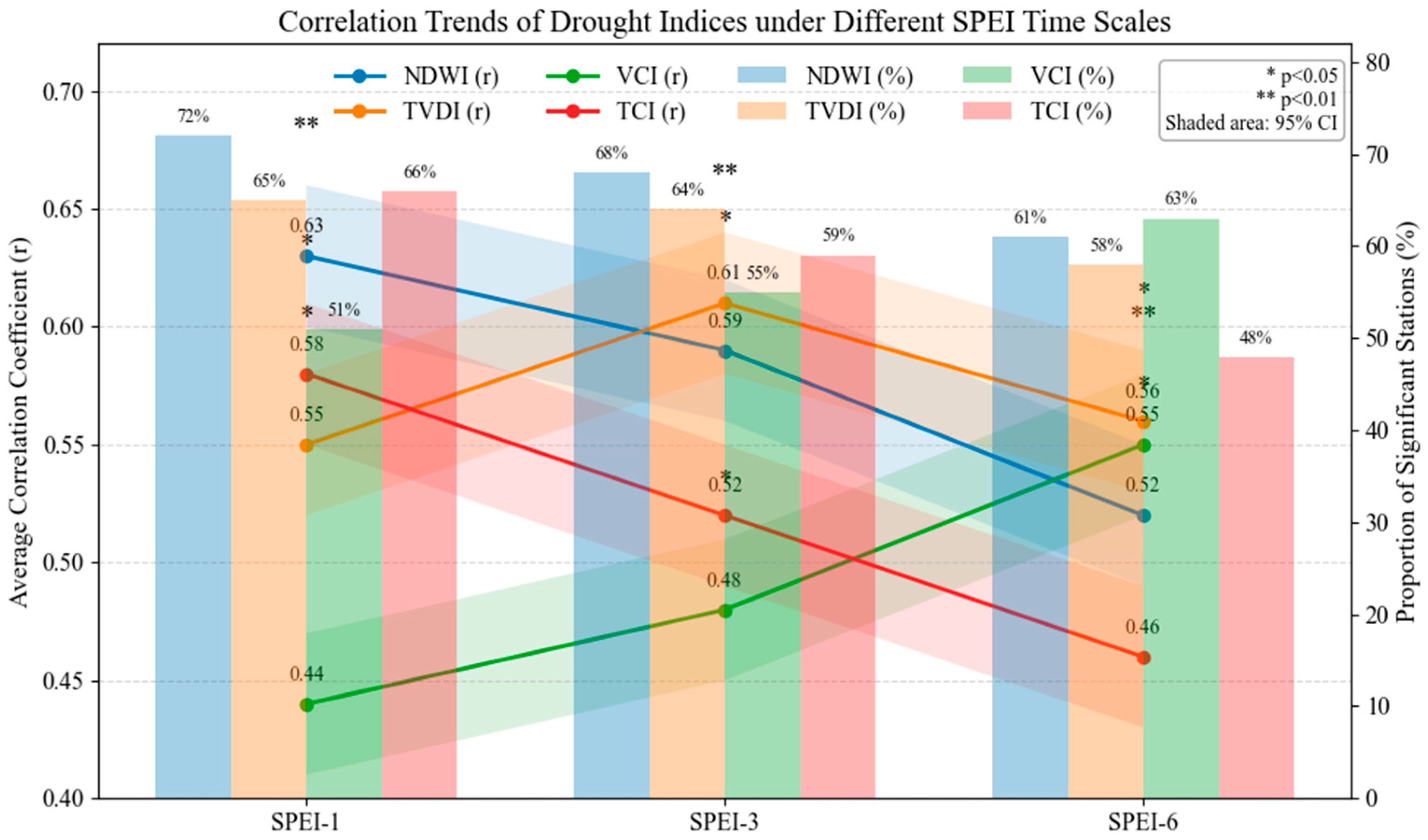
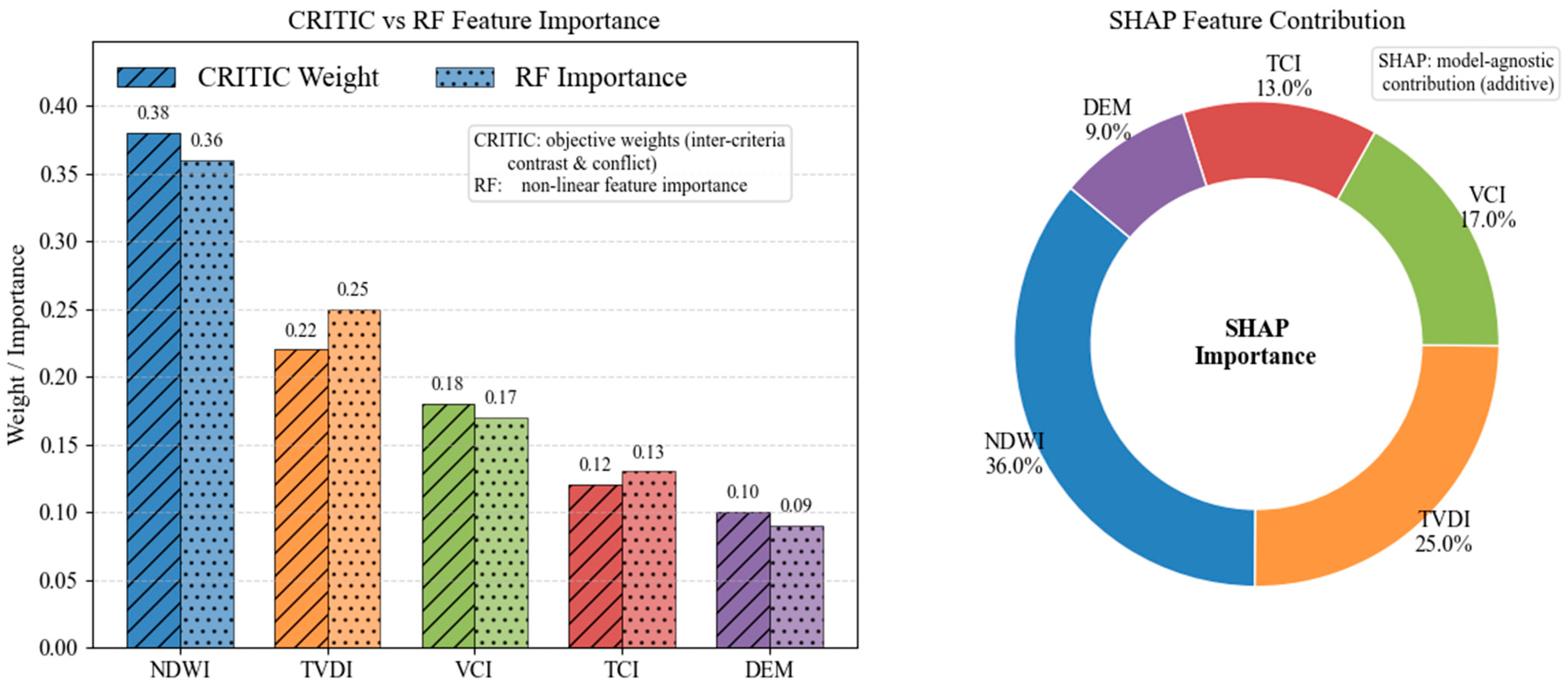
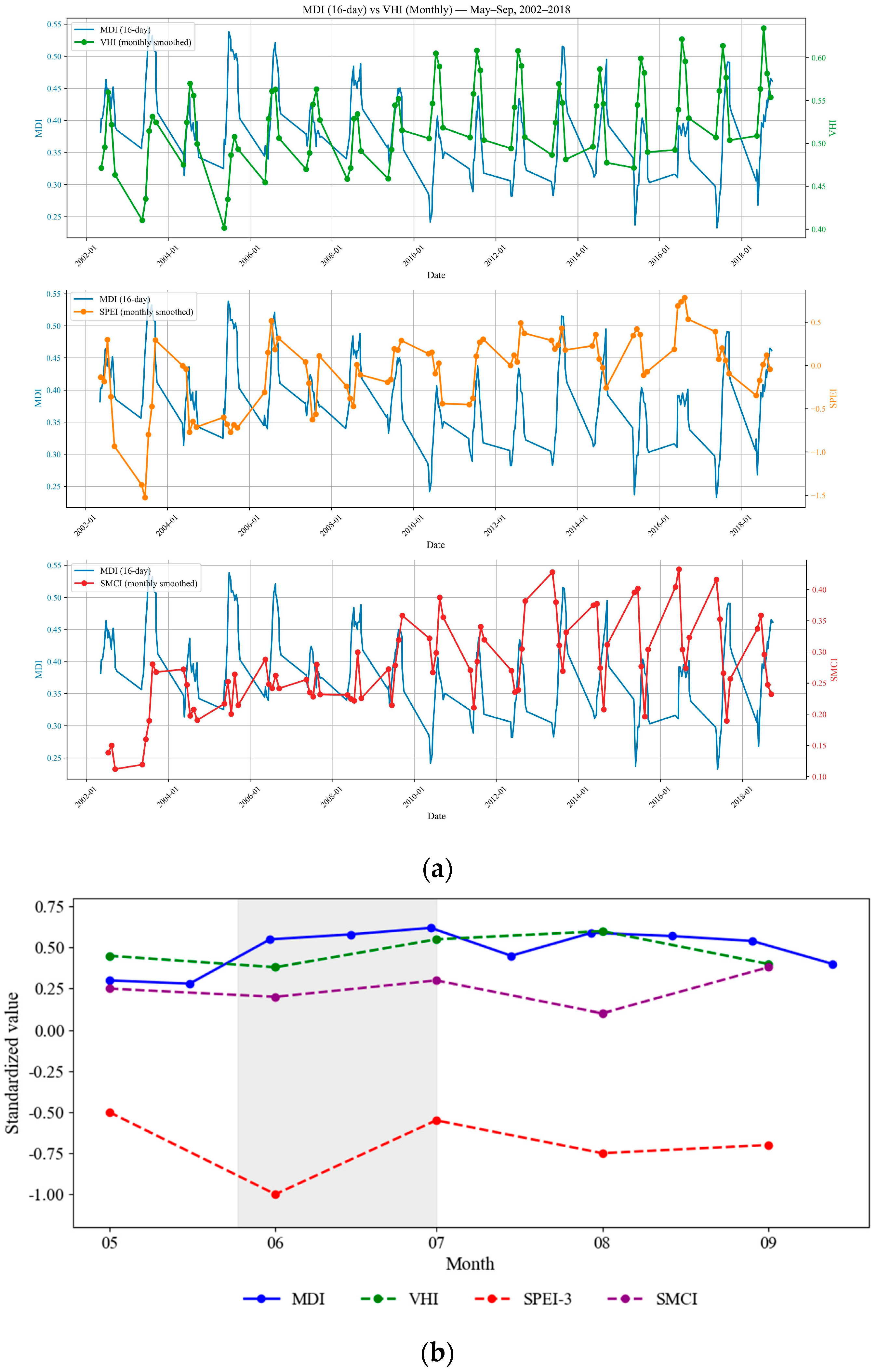
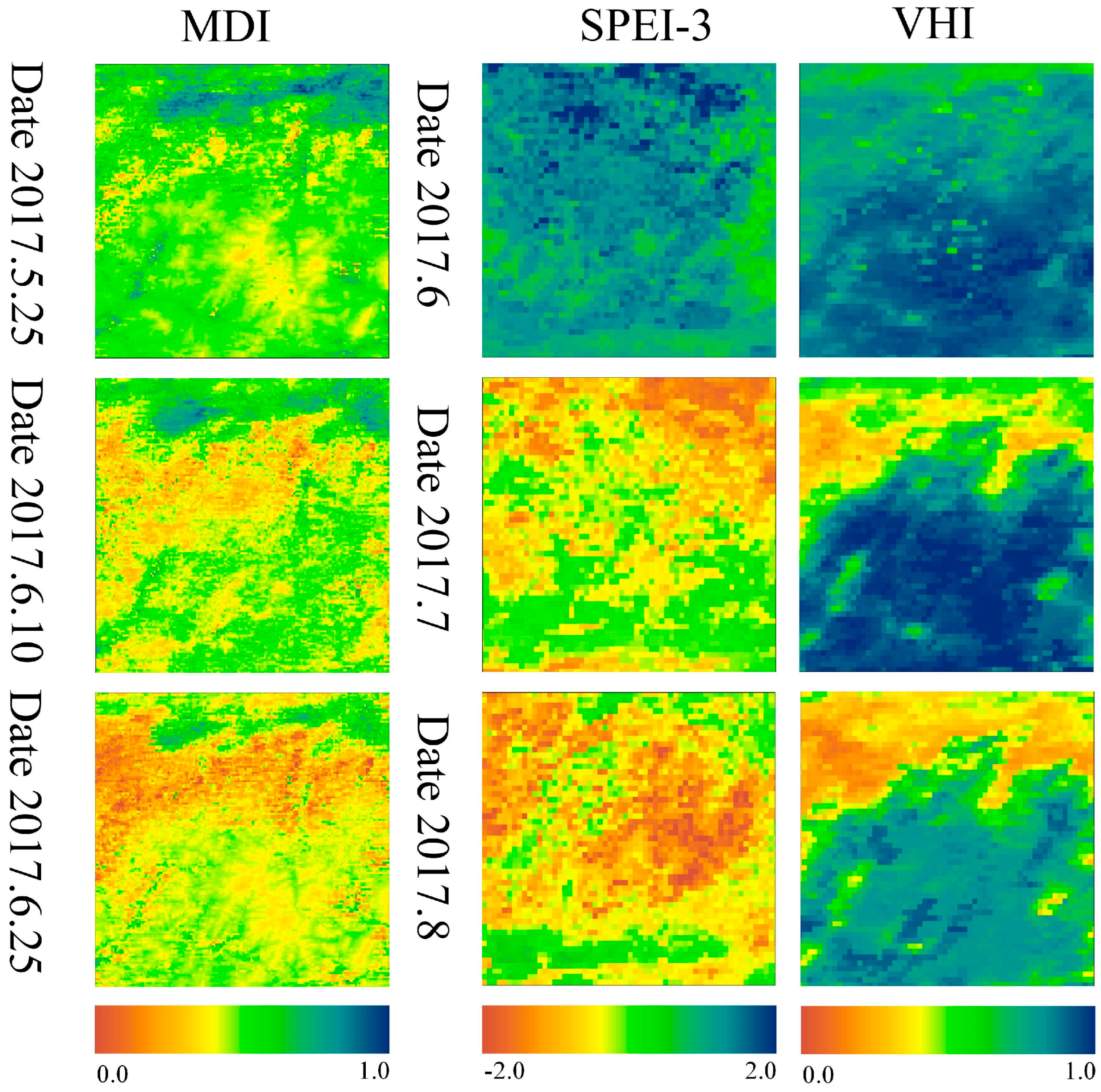
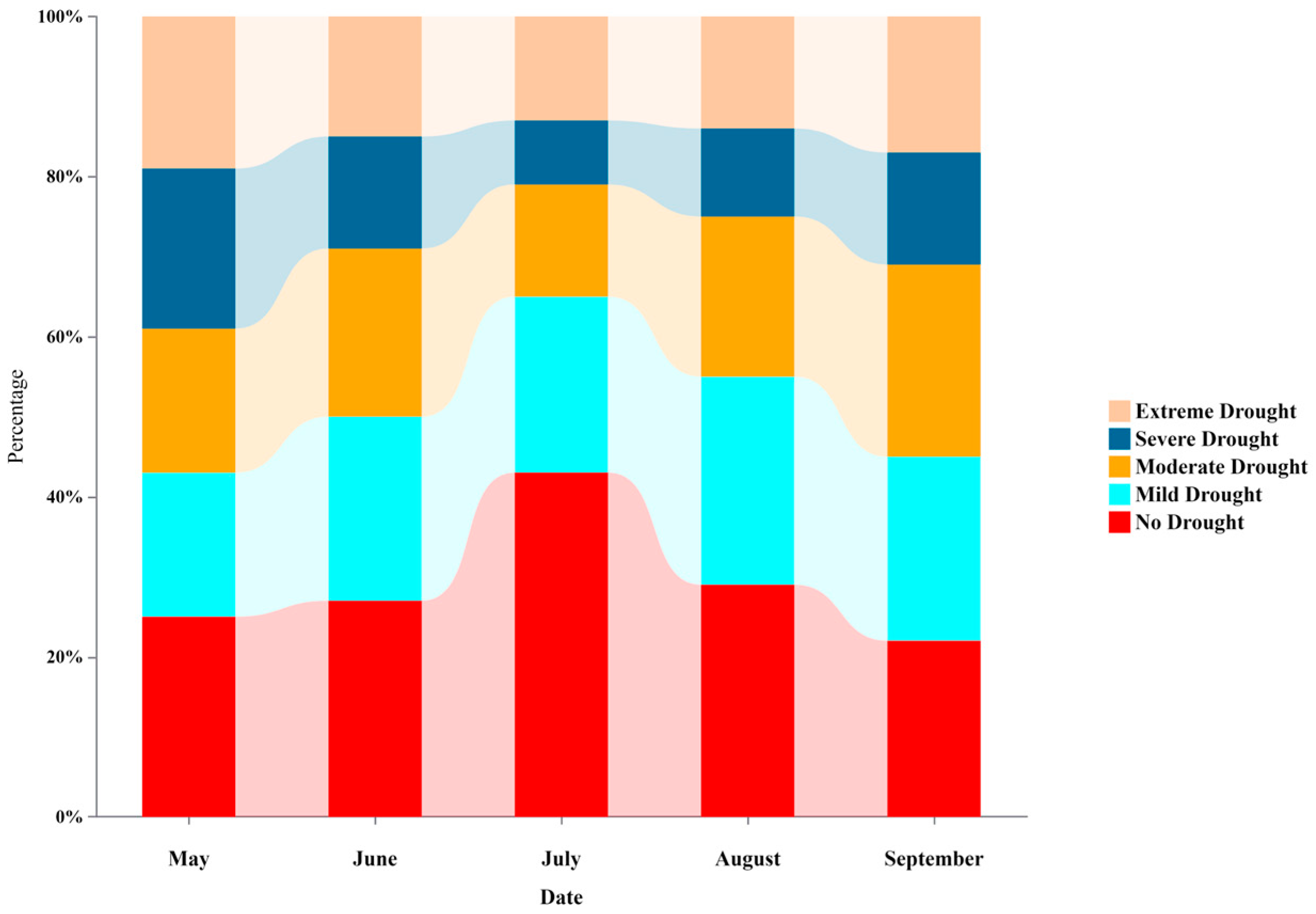
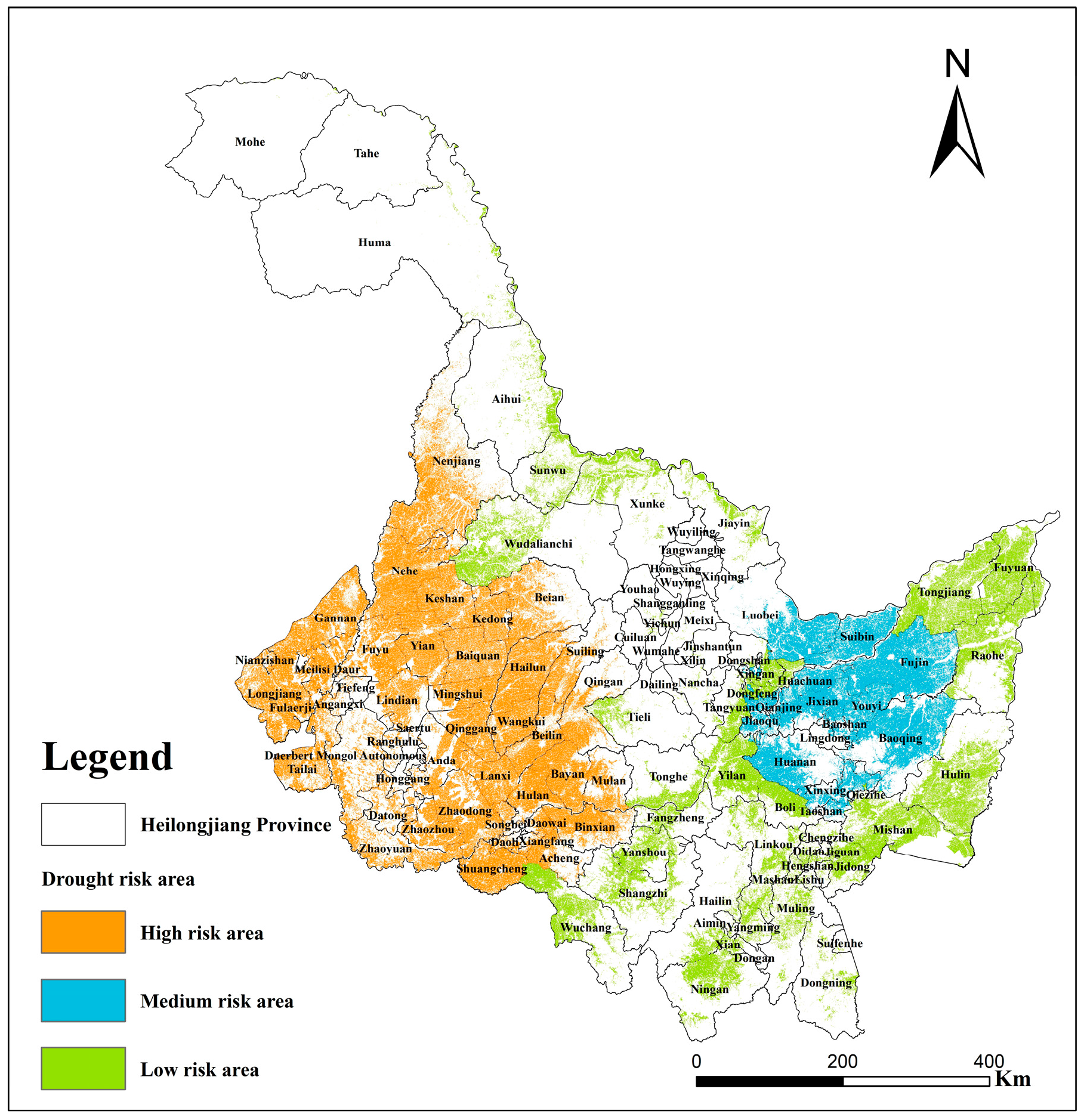
| Indicator | Data Source | Observation Dimension | Application Role | Formula |
|---|---|---|---|---|
| SMCI | SMCI1.0 (CAS NWIEER) | Soil moisture | Soil moisture reference [19] | |
| VHI | MODIS composite | Vegetation + temperature | Classical remote sensing reference [35] | |
| SPEI | Meteorological data | Water balance | Meteorological benchmark [36] |
| Index | R2 | RMSE | Correlation (r) | Accuracy (%) |
|---|---|---|---|---|
| NDWI | 0.75 | 0.12 | 0.79 | 74.5 |
| TVDI | 0.78 | 0.11 | 0.81 | 76.8 |
| VCI | 0.69 | 0.14 | 0.74 | 69.2 |
| TCI | 0.71 | 0.13 | 0.76 | 71 |
| VHI | 0.7 | 0.13 | 0.73 | 70.4 |
| MDI | 0.87 | 0.08 | 0.87 | 87.4 |
Disclaimer/Publisher’s Note: The statements, opinions and data contained in all publications are solely those of the individual author(s) and contributor(s) and not of MDPI and/or the editor(s). MDPI and/or the editor(s) disclaim responsibility for any injury to people or property resulting from any ideas, methods, instructions or products referred to in the content. |
© 2025 by the authors. Licensee MDPI, Basel, Switzerland. This article is an open access article distributed under the terms and conditions of the Creative Commons Attribution (CC BY) license (https://creativecommons.org/licenses/by/4.0/).
Share and Cite
Yu, H.; An, Z.; Qi, B.; Wang, Y.; Liu, H.; Liu, J.; Qin, C.; Zhang, H.; Han, X.; Zhang, X.; et al. Development of a Drought Assessment Index Coupling Physically Based Constraints and Data-Driven Approaches. Remote Sens. 2025, 17, 3452. https://doi.org/10.3390/rs17203452
Yu H, An Z, Qi B, Wang Y, Liu H, Liu J, Qin C, Zhang H, Han X, Zhang X, et al. Development of a Drought Assessment Index Coupling Physically Based Constraints and Data-Driven Approaches. Remote Sensing. 2025; 17(20):3452. https://doi.org/10.3390/rs17203452
Chicago/Turabian StyleYu, Helong, Zeyu An, Beisong Qi, Yihao Wang, Huanjun Liu, Jiming Liu, Chuan Qin, Hongjie Zhang, Xinyi Han, Xinle Zhang, and et al. 2025. "Development of a Drought Assessment Index Coupling Physically Based Constraints and Data-Driven Approaches" Remote Sensing 17, no. 20: 3452. https://doi.org/10.3390/rs17203452
APA StyleYu, H., An, Z., Qi, B., Wang, Y., Liu, H., Liu, J., Qin, C., Zhang, H., Han, X., Zhang, X., & Ma, Y. (2025). Development of a Drought Assessment Index Coupling Physically Based Constraints and Data-Driven Approaches. Remote Sensing, 17(20), 3452. https://doi.org/10.3390/rs17203452







